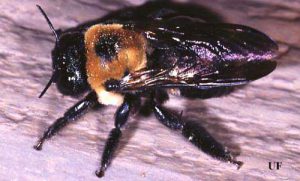The hectic pace to contemporary life can justifiably be compared to the seemingly erratic behavior of insect pollinators. Darting from flower to flower with no apparently logical progression for choice of blooms, all the while emitting a mind numbing buzz.
This incessant and unending grind of bouncing from task to task has created an atmosphere of tedium and monotony which has become the anthem of many adults. As quick as one chore is complete, another replaces it. Russian composer Nokoli Rimsky-Korsakov wrote what might be considered today’s theme song at the dawn of the 20th century. “Flight of the Bumblebee” catches the frantic haste at which this insect functions, as well as its commonly encountered cousin the carpenter bee.
Bumblebees and carpenter bees are very similar in behavior, coloration and size. The easiest way to differentiate these insects is by their abdomen, the body segment furthest from the head. Bumblebees have an abdomen thickly covered in fine hairs. Carpenter bees lack the fine hairs and have a shiny abdomen.
Xyloxop micans Lepeletier, as the large carpenter bee is known scientifically, is one of more than 500 species worldwide. Almost all members of this genus build their nest by burrowing into dead wood. In the wilds of the panhandle this usually means deadfall timber of almost any sort. Unfortunately, in the areas which include human structures, the nesting sites include wooden timbers and siding.
Unlike European honeybees, the carpenter bees are labeled as solitary bees. There may, however, be several nests in close proximity to these active insects.
Nests are composed of a single parent that lays eggs in a segmented tubular nest. The nest openings are a nearly perfect 5/8 inch (16 mm) hole. Each nest has only a single opening, but multiple tunnels will branch off the main passage. These bees do not eat the wood removed to create the nest channels. Sometimes the holes are not visible to the observer, but the wood emits a buzzing or humming sound when these bees are nesting in hidden locations. In many cases small quantities of saw dust can be found on the ground under the hidden nest.
Heavy or repeated infestations can weaken structural timbers and severely damage siding. Decay and breakage will ultimately follow an untreated incursion.
While the damage caused by carpenter bees can be quite expensive, they may attract an even more destructive predator. Woodpeckers, especially the native pileated woodpecker, dine on carpenter bee larvae at every opportunity. These feathery insect assassins are attracted to the vibrations and hums of the bees hidden in wood. In some cases, the wood acts as a resonator and amplified the insect noise which assures an aerial assault. When discovery of the larvae is confirmed, the woodpeckers attack with a ferocity seldom seen in nature. The rapid-fire staccato of their hammering is loud and devastating.
Structural supports are compromised far beyond the damage done by the carpenter bees, and at a quicker rate. Siding is often shredded and left completely useless.
Commonly available insecticides can help control the carpenter bee population and reduce the prospects of woodpecker damage. Unfortunately, this only adds one more item to the long list of chores and task of contemporary adults.
For more information:
Featured Creatures: Large Carpenter Bees
- Get Your Trees Ready For The Winds of October - October 8, 2019
- Feeding Caterpillars Aren’t Always Cute - August 10, 2018
- Wild Azaleas - May 23, 2018

